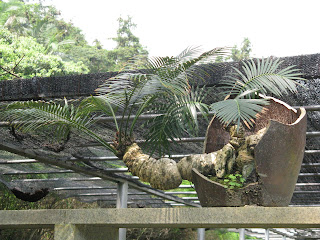As you can see from the slide-show above, I had the opportunity to visit the impressive Sun Yat-Sen Mausoleum (the building complex with blue roofs); the Zhonghua Gate (中华门), the largest gate in the city wall; the Zhonghua Gate penjing collections; and old-town Nanjing. It was incredibly powerful to see the huge city wall in person. Looking closely at the large bricks forming the wall, one can see Chinese characters stamped into them. Upon inquiry, one learns that each brick-maker had to carve or stamp their name and home city into the bricks they made in order to assure the highest quality. If, for any reason, the bricks prematurely crumbled or broke, the brick maker and his entire family would be killed (as a means of assuring quality control). Considering the fact that the wall has survived for six centuries, it is clear to see that the bricks were certainly of the highest quality.
 Some of the characters denoting the name and home town of this brick's maker - a treasure trove delight for historians and anthropologists alike
Some of the characters denoting the name and home town of this brick's maker - a treasure trove delight for historians and anthropologists alikeHowever, as I was on the city wall, I saw portions of the wall that were currently being reconstructed by the government. Later in the day, I was to visit the Nanjing Massacre Memorial Museum (http://www.nj1937.org/english/default.asp), and I learned that much of the wall had been severely damaged by the Japanese forces during WWII. The damaged wall had long testified to the siege of the city, but the Chinese government has recently begun restoring the grand wall back to its pre-WWII condition. The horrible atrocities depicted in the museum brought to life the horrible history that has since been called the "Rape of Nanjing." Walking through the exhibits of the museum, one comes away with a heavy somberness nearly identical to what one experiences at the United States Holocaust Memorial Museum in Washington, DC.
















































